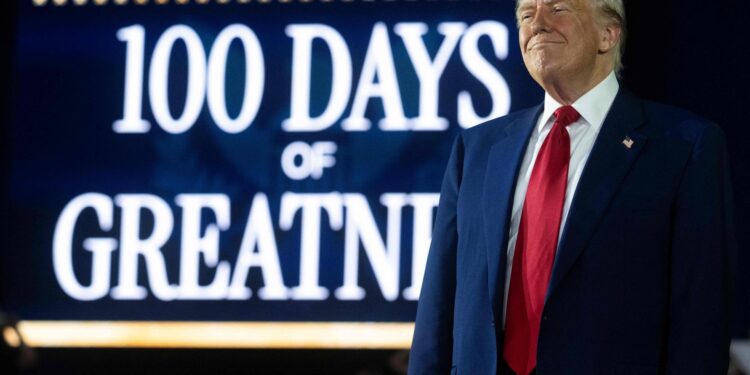In a recent meeting with prominent business leaders, former President Donald Trump acknowledged the challenges facing the United States economy, stating that he requires a “little bit of time” to address ongoing concerns as economic indicators show signs of contraction. This candid admission came amidst reports highlighting a decrease in key economic metrics, prompting leaders from various sectors to seek clarity and direction from Trump. As the nation grapples with inflationary pressures and uncertainty in the job market, this dialogue underscores the complexities of economic stewardship and the critical role of private enterprise in shaping recovery strategies. The implications of Trump’s remarks extend beyond mere rhetoric, as business leaders closely monitor shifts in policy and the broader economic landscape.
Trump Addresses Business Leaders on Economic Challenges and the Need for Patience
In a recent gathering with prominent business leaders, former President Donald Trump emphasized the significance of fostering a robust economic environment amid current challenges. He urged the assembled executives to exhibit patience as the U.S. grapples with a contraction in economic activity. Stressing the need for a collaborative effort, Trump stated that innovation and adaptability are critical drivers for recovery, indicating a path forward in tumultuous times. He reassured the audience of his ongoing commitment to policies that stimulate growth and support businesses through this turbulent phase.
During the discussions, Trump identified several key areas where businesses should focus their attention to navigate the shrinking economy effectively. He listed the following as essential for bolstering resilience and encouraging growth:
- Investment in Technology: Emphasizing the importance of modernization.
- Workforce Development: Preparing employees with new skills for evolving market needs.
- Global Trade Opportunities: Encouraging businesses to explore international markets.
In light of these challenges, Trump assured his audience that with a “little bit of time,” he believes the economy can rebound stronger than before. His remarks resonate with a broader call for unity and forward-thinking strategies among the nation’s top business minds.
Analysis of Economic Shrinkage and Its Implications for American Businesses
The recent contraction of the U.S. economy has raised alarms among business leaders and policymakers alike. As President Trump conveys the need for “a little bit of time” to navigate these troubling waters, American businesses are tasked with recalibrating their strategies to adapt to the potential long-term effects of economic shrinkage. Key implications include shifts in consumer behavior, reduced spending power, and increased uncertainty in investment decisions. In this climate, companies must consider the following factors to maintain operational resilience:
- Cost Management: Streamlining operations and reducing unnecessary expenses will be crucial as revenues may decline.
- Market Adaptation: Businesses need to identify shifting consumer preferences and pivot to meet evolving demands.
- Liquidity Strategy: Ensuring sufficient cash reserves to weather potential downturns will be essential for survival.
Additionally, companies must engage in proactive financial planning to navigate looming challenges in the market. An examination of historical economic contractions reveals that businesses often emerge stronger by focusing on innovation and efficiency during tough times. Economic data suggests that sectors such as e-commerce, healthcare technology, and renewable energy may be well-positioned for growth, even amidst a shrinking economy. The table below illustrates the projected growth areas for businesses amid economic challenges:
| Sector | Projected Growth Rate |
|---|---|
| E-commerce | 15% annually |
| Healthcare Technology | 10% annually |
| Renewable Energy | 8% annually |
Ultimately, the outcomes of this economic shrinkage will depend on the adaptability and innovative capabilities of American businesses. As leadership urges resilience and patience, it becomes clearer that the path to recovery will require strategic foresight amid uncertainty.
Strategic Recommendations for Businesses Navigating Uncertain Economic Times
In light of the recent economic downturn, businesses are urged to adopt a proactive approach to navigate uncertainties. Key recommendations include:
- Diversification of Revenue Streams: Companies should explore new markets and product lines to mitigate risks associated with reliance on a single source of income.
- Cost Management Strategies: Implementing rigorous cost control measures can help in maintaining cash flow without sacrificing quality.
- Investing in Digital Transformation: Businesses must prioritize technology investments that enhance operational efficiency and customer engagement.
- Strengthening Supply Chain Resiliency: A thorough review and enhancement of supply chain operations can prepare businesses for potential disruptions.
Furthermore, fostering a culture of adaptability is essential for long-term success. Companies should enhance their workforce’s skills through training and development programs, ensuring employees are equipped for changing market demands. For strategic planning, organizations may consider utilizing a SWOT analysis to identify strengths, weaknesses, opportunities, and threats in their current operational environment. Below is a simplified representation:
| Strengths | Weaknesses | Opportunities | Threats |
|---|---|---|---|
| Established Customer Base | High Operational Costs | Emerging Markets | Intense Competition |
| Innovative Products | Lack of Digital Presence | Technological Advancements | Regulatory Changes |
Future Outlook
President Trump’s recent discussions with business leaders highlight the growing concerns surrounding the US economy, which has begun to show signs of contraction. His plea for a “little bit of time” underscores the administration’s awareness of the complexities and challenges ahead as it seeks to navigate these turbulent economic waters. As CEOs and stakeholders reflect on the President’s message, all eyes will be on how the administration responds to the evolving economic landscape and whether policy adjustments will be implemented to address the shrinking economy. With uncertainty on the horizon, the coming weeks will be pivotal for both the business community and the broader market.






























